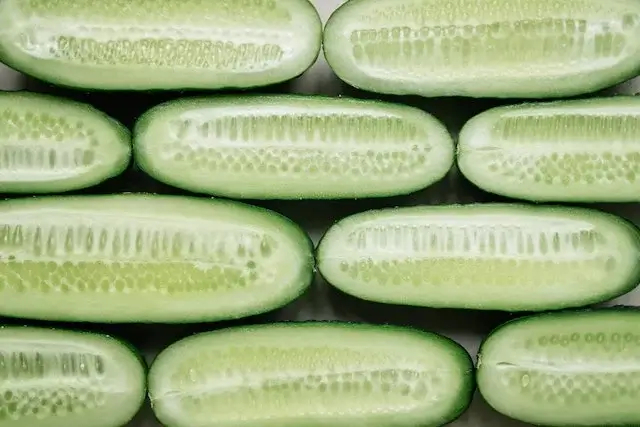Archives
Avoid Common Thanksgiving Migraine Triggers
Pumpkin Spice Bedtime Drink (Vegan)
Enjoy the 4th: Don’t Let a Migraine Rain on Your Parade
5 Water-Rich Foods to Stay Hydrated in the Heat
Being hydrated is extremely important for your health. When you don’t drink enough water, your body cannot function properly, causing you to experience a host of uncomfortable and sometimes dangerous symptoms.
Dehydration happens when a person loses more fluid than they take in, either through natural processes like sweating and urination, when you have a fever or after a vomiting or diarrhea bout. It is more likely to occur when the weather is warm or during periods of profuse sweating, like during exercise or when you spend too much time sitting in the sun.
Dehydration is one of the most common migraines and headache triggers. Many migraineurs and chronic headache sufferers report that, for them, even the slightest hint of dehydration can spiral into a full-fledge migraine attack within minutes. Fortunately, it is also one of the most easily prevented triggers.
Staying adequately hydrated is something we should strive for year-round. Here are five water-rich foods that will help you stay hydrated during summer and beyond:
Watermelon
Water content: 92%
Nothing says summer like eating an ice-cold watermelon wedge sitting by the pool or at the beach. This delicious fruit is almost entirely made of water, and it is very healthy, too. A one-cup (155 grams) serving of watermelon contains about 120 milliliters (or half a cup) of water. And as far as fruits go, it is also one of the lowest in calories, with only 46 calories per cup. Watermelons also have a number of migraine-friendly nutrients, like vitamins A and C, potassium, and magnesium, making it the ideal on-the-go snack for migraineurs with food sensitivities.
Cucumber
Water content: 96.7%
Although technically a fruit, cucumbers are often regarded as one of the most hydrating and refreshing vegetables there is. They are also one of the most ancient plant foods ever recorded. Cave excavations and anthropological studies have shown that humans have been growing these water-laden veggies more than 3,000 years for food and medicinal purposes. Often considered to be a “diet food,” cucumbers are loaded with vitamins and minerals that may offer several health benefits. There is evidence that cucumbers may support:
- Hydration
- Bone health
- Cardiovascular health
Lettuce
Water Content: 96%
We haven’t been fair to lettuce. Fresh, crisp, and crunchy, there is almost no dish that doesn’t go well with a refreshing salad on the side. There are five main types of lettuce: leaf, romaine, crisphead, butterhead, and stem, and each provides different levels of nutrition. Generally speaking, lettuce is very low in calories (only ten calories per cup) but high in fiber, and it also has small amounts of essential vitamins and minerals such as vitamins A and K, zinc, and potassium.
Celery
Water content: 94%
Some people love it, some hate it, but there’s no denying that these crunchy stalks offer more than a handful of health benefits for very few calories. Just a serving of celery provides almost a third of the recommended daily intake of vitamin K, a nutrient closely related to bone health. A cup of celery also has nearly as much potassium as a small banana and packs close to half a cup of water. However, that same cup of celery only contains about 15 calories.
Tip: Don’t toss the leaves! Most of the calcium, vitamin C, and potassium in celery comes from them. Celery leaves don’t store well, so choose stalks with bright, crisp leaves to make sure they are as fresh as possible and eat them right away.
Tomatoes
Water content: 94%
Like cucumbers, despite botanically being a fruit, tomatoes are considered a vegetable by most. They are an important source of several key nutrients, including folate, vitamin C, and potassium. But that’s not where their impressive nutritional profile ends. Tomatoes have a water content of nearly 95%, making them one of the most hydrating non-starchy vegetables. They are also packed with an extraordinary antioxidant called lycopene.

Lycopene is a red pigment and antioxidant known for its health benefits. Studies have shown that lycopene’s antioxidant properties can help regulate free radicals in the body, promote heart health, and may even slow down the progression of some types of cancer.
Used in many cuisines around the world, there are countless ways to prepare and eat tomatoes. Raw, baked, and fried are the most popular ways to make them, but if you are in the mood for something new, try:
- Stuffing them: with cheese, breadcrumbs, herbs.
- Grilling them: by themselves or in skewers.
- Pickling them: in boiled pickling brine.
- Boiling them: to make sweet or savory tomato jam.
More on dehydration
Fourth of July – Cake Recipes with Summertime Berries
Summertime is berry time. When the hot days of summer hit, these small bites of juicy sweetness are a perfect pick-me-up. Work fresh berries into your 4th of July celebration with one of the cake recipes below and have a happy 4th of July!
Berry tip: Do not wash berries until you’re ready to use them. Wash strawberries with the hull on, then hull and slice them.
Angel Food Cake Stuffed with Whipped Cream and Berries

Note – for those of you who do not like to cook, you can purchase the whip cream and angel food cake pre-made (or use box mix)
See below for tastiest version from Recipes.com
This summery sweet takes three basics–cake, whipped cream, and berries–and elevates them to showstopper status with a few neat tricks. Ginger and orange juice brighten the light, spongy angel food cake, while vanilla bean seeds perfume the whipped cream. The berries are stashed inside the cake itself, their bright color offering a visual surprise with every slice.
Ingredients
Berries:
- 2 cups fresh raspberries
- 1-1/2 cups fresh blackberries
- 1-1/2 cups fresh blueberries
- 1/4 cup granulated sugar
- 2 tablespoons fresh orange juice
Cake:
- 1 cup cake flour (about 4 ounces)
- 1 cup powdered sugar, divided
- 1/2 teaspoon ground ginger
- 3/4 cup granulated sugar
- 12 large egg whites
- 1 teaspoon cream of tartar
- 1/2 teaspoon salt
- 2 tablespoons fresh orange juice
Whipped cream:
- 3/4 cup whipping cream, chilled
- 1/2 vanilla bean, split lengthwise
- 3/4 cup powdered sugar
- Remaining ingredients:
- 2 tablespoons powdered sugar
- Grated orange rind (optional)
Preparation
- To prepare berries, combine first 5 ingredients; toss to combine. Cover and chill 1 hour.
- Preheat oven to 375°.
- To prepare cake, place a rack in the lower third of oven. Lightly spoon flour into a dry measuring cup; level with a knife. Sift together flour, 1/2 cup powdered sugar, and ginger in a medium bowl. Sift together remaining 1/2 cup powdered sugar and 3/4 cup granulated sugar in another bowl. Place egg whites in a large bowl; beat with a mixer at high speed until foamy. Add cream of tartar and salt; beat until soft peaks form. Add powdered and granulated sugar mixture, 1 tablespoon at a time, beating until stiff peaks form. Sift flour mixture over egg white mixture, 1/4 cup at a time; fold in. Fold in 2 tablespoons juice.
- Spoon batter into an ungreased 10-inch tube pan, spreading evenly. Break air pockets by cutting through batter with a knife. Bake at 375° for 30 minutes or until cake springs back when lightly touched. Invert pan; cool completely. Loosen cake from sides of pan using a narrow metal spatula. Invert the cake onto a plate.
- Cut 1 inch off top of cake using a serrated knife; set top of cake aside. Hollow out bottom of cake using a small knife, leaving a 1-inch-thick shell; reserve torn cake for another use.
- To prepare whipped cream, place cream in a medium bowl; beat with a mixer at high speed until soft peaks form. Scrape seeds from vanilla bean into bowl; discard pod. Gradually add 3/4 cup powdered sugar, beating at high speed until stiff peaks form.
- Spoon all but 1 cup of berry mixture into cake shell; top with whipped cream. Replace top of cake; sprinkle with 2 tablespoons powdered sugar. Serve immediately with additional berry mixture; garnish with orange rind, if desired.
Sugar-Free Angel Food Cake Version:
- Egg whites-12
- Cream of Tarter – 1 1/2 tsp
- Water – 1 Tbs
- Vanilla extract 1 tsp
- Sugar alternative (use any granular alternative equivalent to 1-3/4 cups of sugar.
- Salt 1/2 tsp
- Cake flour
On a mixing bowl use a whisk attachment to whip together the egg whites until some peaks begin to form. Then add the cream of tarter, water and vanilla extract. While your ingredients are mixing,you can sift together your flour, sugar alternative, and salt. You will need to sift this very well so I would suggest sifting several times or even using a food processor. Set your oven to 325 at this point and then mix together your ingredients by adding the dry ingredients to the mixing bowl with the wet ingredients. We do not want the oven to be too-preheated which is why we are doing a ‘lazy’ preheat. Now pour the batter into your prepped pan and bake for 60-65 minutes or until golden. (More recipes at thesugarfreediva.com Invert cake while still in pan to cool. Frost or serve with sugar-free whipped topping, sour cream and or fresh fruit.
Angel Food Cake – Whip Cream & Berries

If you are really in a hurry, you can bake or buy a plain Angel Food cake, slap on whip cream and top with berries for simple refreshing desert.
Angel Food -Berry Skewers

Even more simple, and fun to eat are skewers with alternating berries and slices of Angel Food cake.
You can also, take out much of the preparation time if you just serve a plain angel food cake, with sides o
berries and whip cream so your guests can help themselves.
Easy Fourth of July Cake – (white cake- blueberries and strawberries)

2 pints of strawberries
1 box white or yellow cake
1 1/3 C of blueberries
1 tub of whipped topping
- Mix up and bake your cake according to the box’s directions.
- Slice 1 cup of strawberries, set aside. Halve remaining strawberries, set aside.
- Top cake (in pan) with 1 cup sliced strawberries, 1 cup blueberries and all of the whipped topping. Arrange remaining strawberry halves and blueberries on whipped topping to create a flag design.
- Refrigerate until ready to serve.
Fourth of July Flag Cake – Chocolate with Cream Cheese Frosting – Blueberries and Raspberries
– from Epicurious

Ingredients
For the cake:
- 1 cup boiling water
- 3/4 cup natural unsweetened cocoa powder
- 1 tablespoon instant coffee granules
- 1/2 cup whole milk
- 1 1/2 teaspoons pure vanilla extract
- 2 cups all-purpose flour, plus additional flour for dusting pan
- 1 1/4 teaspoons baking soda
- 1/2 teaspoon salt
- 2 sticks (1/2 pound) unsalted butter, softened, plus additional butter for greasing pan
- 1 cup packed light brown sugar
- 1 cup sugar
- 4 large eggs
For the frosting:
- 2 (8-ounce) packages cream cheese, at room temperature
- 2 sticks (1/2 pound) unsalted butter, at room temperature
- 1 1/2 teaspoons pure vanilla extract
- 1 1/2 cups confectioners’ sugar, sifted
For the decorations:
- 1 1/2 pints raspberries (about 3 cups total)
- 1/2 pint blueberries (about 1 cup total)
- Equipment: 13- by 9-inch metal baking pan, stand mixer fitted with the paddle attachment, pastry bag, star-shaped pastry tip (such as Wilton #2110)
Preparation
Make the cake:
Position a rack in the middle of the oven and preheat to 350°F.
Butter the bottom and sides of a 13- by 9-inch metal baking pan and line the bottom with wax or parchment paper. Butter the paper and dust the pan with flour, knocking out any excess.
In a medium bowl, whisk together the boiling water, cocoa powder, and instant coffee granules until smooth. Whisk in the milk and vanilla.
In a second medium bowl, sift together the flour, baking soda, and salt.
In the bowl of a stand mixer fitted with the paddle attachment, combine the butter with both sugars and beat on medium until light and fluffy, about 3 minutes. Add the eggs, one at a time, and beat on medium until fully incorporated. Reduce the speed to low and add the flour and cocoa powder mixtures in batches, beginning and ending with the flour mixture. (The batter may look curdled.) Pour the batter into the prepared pan, smoothing the top, and bake the cake until a wooden toothpick inserted in the center comes out clean and the cake begins to pull away from the sides of the pan, 35 to 40 minutes. Let the cake cool in the pan on a rack for 10 minutes, then invert the cake onto the rack, remove the wax or parchment paper, and let it cool completely. DO AHEAD: The unfrosted cake, can be cooled, wrapped securely in plastic wrap, and stored at room temperature up to 24 hours, before assembling and serving.
Make the frosting:
In the bowl of a stand mixer fitted with the paddle attachment, combine the cream cheese and butter and beat until creamy and smooth, 3 to 5 minutes. Beat in the vanilla extract. With the mixer on low, add the sifted confectioners’ sugar in three batches, mixing until fully incorporated. Increase the speed to medium-high and beat until the frosting is smooth. Chill the frosting in the refrigerator for 30 minutes before assembling the cake.
Assemble and serve the cake:
Frost the top and sides of the cake with 2 1/2 cups of the frosting. Transfer the remaining frosting to a pastry bag fitted with the star tip.
Using a toothpick or small knife, outline a 4 1/2-inch-long by 3 1/2-inch-wide rectangle in the top left corner of the cake. This area will be reserved for blueberries.
Starting with the longer side of the cake that is closest to you, pipe a line of frosting along the top edge of the cake then arrange two horizontal rows of raspberries directly above the line of frosting. Pipe a second line of frosting above the raspberries and arrange two more horizontal rows of raspberries directly above the frosting. Repeat this process two more times, making sure to exclude the top left corner that is reserved for the blueberries. Arrange the blueberries in horizontal rows in the top left corner of the cake.
Slice and serve the cake immediately or store it, covered securely in plastic wrap, in the refrigerator until ready to serve.
4th of July tip for migraineurs…
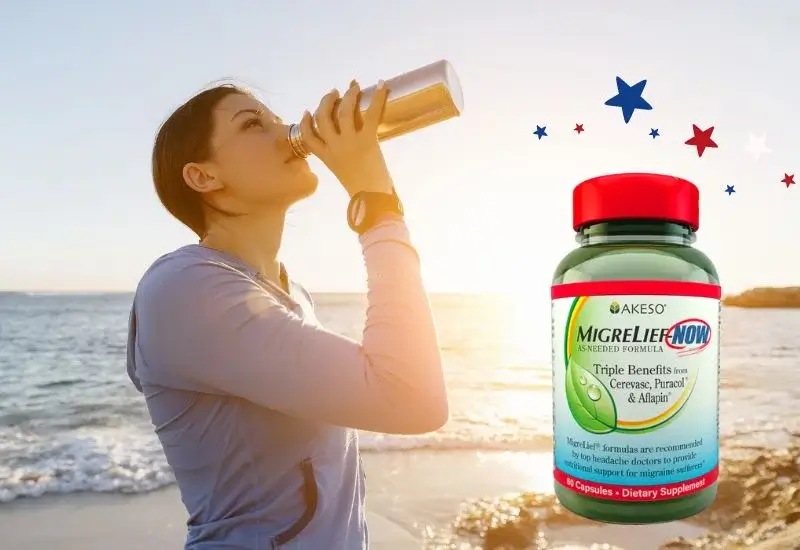
Migraine and Headache Awareness Month – Experts Weigh In
June is recognized as National Migraine and Headache Awareness Month dedicated to sharing more understanding of these common and debilitating conditions. In case you missed them, here are a few informative articles where experts weighed in on migraine.
How Functional Medicine Treats Migraine – Akeso Health Sciences
Migraine – Prominent neurologists weighs in – Newsmax
Psychiatric Comorbidities Associated with Migraine – The Clinical Advisor
Migraine in the Emergency Department – When to go to the ED for Migraine – The American Migraine Foundation
From diet to disasters, lifestyle factors can affect headaches and migraine – Headache, The Journal of Head and Face Pain
What are MigreLief Side Effects?
Migraine and Mental Health: What’s the Link? Plus 5 Tips for Both
If you suffer from migraine, you know firsthand that it can do a number on your mental health. Migraine attacks can reduce your quality of life and even cause you to put your life on hold. It’s hard to get a handle on your mental health when you’re fearing your next migraine attack nonstop.
Over time this can wear you down physically, mentally, and emotionally. No wonder migraine and mental health issues often go hand in hand! This article breaks down the data linking migraine and mental health issues and offers six helpful tips for managing them both.
What’s the Relationship Between Migraine and Mental Health?
There is a bidirectional relationship between migraine and mental health – meaning one affects the other. A survey of 6,000 adults found that people with migraine are twice as likely to struggle with mental health problems. (1)
So, let’s delve a little deeper into what the data has to say:
Depression and Migraine
People with migraine are five times more likely to experience depression. (2) And the risk of depression rises with more frequent attacks. One study found that chronic migraine sufferers were twice as likely to deal with depression as those with episodic migraine. (3)

Which isn’t all that surprising. Migraine attacks can be lonely. You’re often hunkered down in a dark, quiet room, waiting for the pain to pass. Plus, migraine attacks may leave you missing out on fun social gatherings or quality time with family.
You might feel racked with guilt every time you have to cancel plans last minute. Or you might feel like no one understands your migraine struggles. This only intensifies feelings of depression and sadness.
Anxiety and Migraine
Depression is common for people with migraine, but anxiety is even more pronounced. One study found that people with migraine were 25 times more likely to feel anxiety than those who live migraine-free. What’s more, migraine patients were also 49 times more likely to deal with chronic worrying. (4)
Which makes total sense – migraine sufferers often live in constant anxiety about when the next attack might strike. Knowing that you may have to hit the pause button on your life at any time can fuel a steady stream of anxiety.
Bipolar Disorder and Migraine
Comorbid bipolar disorder and migraine have a profound connection. Only about 12% of the population suffers from migraine. Yet, one meta-analysis found that 32% of people with Bipolar I and 54% with Bipolar II disorder experience migraine. (5)
Clearly, migraine and mental health are inextricably linked. But the question is – why? Does migraine cause mental illness? Or is it the other way around?
While there’s no clear answer, scientists do have some theories.
What Causes Migraine?
Scientists haven’t nailed down the exact cause of migraine. But it’s thought to be a combo of genetics and abnormal brain activity.
In the past, migraine was thought to be caused by problems with blood flow to the brain. But today, many scientists think it’s due to overactive nerve cells triggering your trigeminal nerve.
Your trigeminal nerve contains receptors for serotonin. You might know serotonin as the ‘feel-good’ neurotransmitter often low in people with depression and anxiety. But it’s also needed for communication between nerve cells.
When serotonin runs high, your blood vessels shrink. But when it runs low, your blood vessels swell, which can lead to pain. That’s why when serotonin gets out of whack, it can disrupt your migraine and mental health.
Hormones are also likely part of the migraine puzzle. Changes in estrogen impact serotonin levels and can trigger migraine attacks. This is why women are three times more likely to suffer from migraine than men.
And then, of course, there are triggers that can spur on a migraine attack. Some triggers are environmental, such as strong scents, bright lights, or weather changes. Migraines can also be set off by lifestyle factors such as stress, poor sleep, and an unhealthy diet.
This is why practicing self-care is critical for anyone dealing with migraine.
How to Manage Your Migraine and Mental Health Naturally
Migraine attacks are unpredictable and can make you feel like your body is out of your control.
Yet, you have more power than you think. When it comes to migraine, prevention is where the power lies.
So here are some healthy lifestyle habits that can help tame migraine and benefit your mental health:
Exercise
Regular exercise relieves stress, improves sleep, and releases endorphins, your body’s natural painkillers. Studies show people who exercise regularly are less likely to experience depression and anxiety. (6)
Being sedentary is also linked with increased migraine frequency. (7) So get your body moving! Just be sure not to overdo it. Intense exercise can trigger migraine attacks in some people.
Not sure where to start? Check out this article for helpful tips on the best exercises for migraine.
Stress Relief
Stress is the most common migraine trigger. So getting your stress in check is key to managing your migraine and mental health.
There are tons of stress-busting techniques you can try. Here are a few:
-
Meditation trains you to be mindful of your thoughts, feelings, and sensations without identifying with them. Over time this can help you bust out of negative thought loops before they take hold. Research shows meditation increases gray matter in the brain, which is reduced in people with migraine. (8, 9) Nowadays, there are several handy apps like Calm and Headspace that can teach you how to meditate.
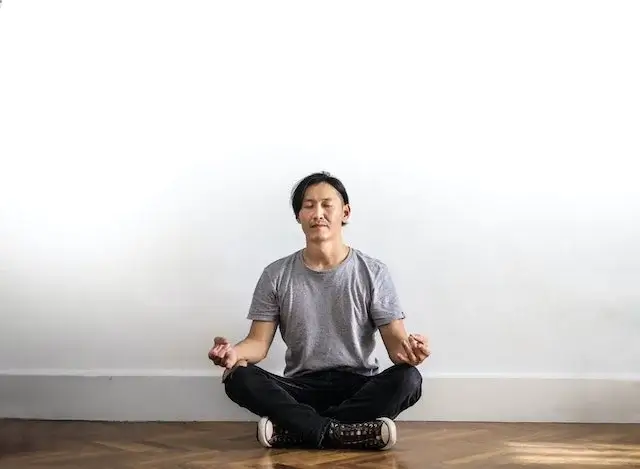
- Yoga is proven to reduce stress, anxiety, and depression. (10) Its powerful combo of deep breathing and muscle relaxation relieves stress, making it the perfect migraine prevention tool. These five yoga poses work particularly well for migraine relief.
- Stretching can relieve tension in your neck and muscles if yoga isn’t your thing. Done regularly, they can prevent muscle tension from building up. The next time you need to relax and unwind, try out these stretches.
- Deep breathing calms your nervous system to keep stress at bay. And best of all, you can practice it anywhere! So the next you feel stress creeping up, whether you’re sitting in traffic or lying in bed amid an attack, take some slow deep belly breaths. Here’s a video that can help guide the way:
Natural Treatment Options
There are many pharmaceutical options available to treat migraine. Unfortunately, they often come with a long list of side effects. Luckily, there are several natural treatment options that can help you manage your migraine and mental well-being.
Cognitive Behavioral Therapy (CBT)
Cognitive-behavioral therapy trains you to reframe unhelpful thought patterns that may be amplifying feelings of depression or anxiety. Research shows CBT effectively treats a variety of mental health disorders, including depression, generalized anxiety, agoraphobia, social phobia, PTSD, and panic disorder. (11)
Yet cognitive behavioral therapy benefits migraine as well. Research shows it can reduce migraine frequency and intensity. (12) To find a therapist who practices CBT, click here.
Biofeedback
Biofeedback involves attaching electrodes to your body to track how you respond to stress. This technique is typically done via an electromyogram (EMG) feedback device. Over time, biofeedback trains your body to relax when under stress. Studies show biofeedback can reduce the duration and intensity of migraine pain. (13)
Nutritional Support
Several nutrients and herbs can offer powerful support for your mental health and migraine management. Luckily, we’ve done the research for you with these condition-specific formulas:
-
Migrelief contains a potent combo of riboflavin, magnesium, and Puracol feverfew. It’s been offering targeted nutritional support for migraine sufferers for over 25 years.
-
Resilient Mood promotes a positive mental outlook with its medley of Rhodiola, 5-HTP, saffron, and methylfolate. It helps balance your feel-good hormones and provides adaptogenic support to relieve stress.
- Calm and Clever helps calm anxiety and promotes positive mood and sleep by reducing your stress hormone cortisol.
Takeaways
Migraine and mental health impact one another – that much is clear. Migraine sufferers are more likely to deal with depression, anxiety, and even bipolar disorder. But feelings of stress and anxiety can trigger migraine attacks too.
However, you’re not powerless. Prevention is powerful stuff. Practicing healthy lifestyle habits can lessen migraine intensity and even prevent future attacks. And natural treatment options can offer extra support to manage both your migraine and mental health.
The Link Between Migraine and ADHD: Breaking it Down
Living with migraine is tough. But stack ADHD on top it, and it takes those challenges to a whole new level.
And believe it or not, this combo is more common than you’d think. Research shows there’s a connection between migraine and ADHD. People with migraine are more likely to have ADHD – and vice versa.
This article breaks down what the science has to say about this link and offer tips and tools for treating ADHD and migraine.
ADHD and Migraine: What’s the Relationship?
On the surface, migraine and ADHD may seem to have little in common. Besides both being health conditions that severely disrupt your life.
But studies have found the two are comorbid disorders – in adults and children.
One 2011 study found that migraine is far more common among adults with ADHD. In the study:
- Men with ADHD were over twice as likely to have migraine (22.5% vs. 10.7%)
- The difference was significant for women as well (34.4% vs. 24.9%)
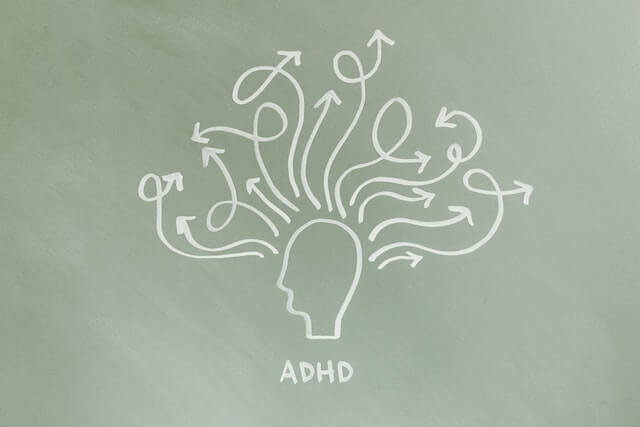
Another 2018 study analyzed data from 26,456 participants from the Danish Blood Donor study. They too found a strong association between migraine and ADHD.
Unlike the previous study, the risk of ADHD and migraine was more pronounced in females. They also found that the risk increased with age, peaking in the early 50s.
The migraine-ADHD comorbidity was even more profound for adults with migraine with aura.
But link rings true for children as well. One study of 5,671 children found that ADHD is far more prevalent in children with migraine. What’s more, as migraine frequency increased, so did ADHD risk.
So clearly, the two conditions are connected. Yet, the whys aren’t fully understood.
Can ADHD Cause Migraines?
Researchers aren’t sure. Some believe the comorbidity is related to genetic and environmental factors. This suggests that certain people may simply be susceptible to both conditions.
But many other theories try to explain their connection as well. Here are a few:
Dopamine dysfunction
Some research suggests that ADHD may be due to dopamine dysfunction. Dopamine is a neurotransmitter involved in memory, mood, attention, and much more.
Known as a ‘feel good hormone’ it plays a part in the reward centers of your brain. In short, it helps you feel happy and keeps your motivation up. So when dopamine goes awry, it can present challenges.
And it turns out, dopamine may play a role in migraine as well. There is evidence that migraine symptoms may be triggered by changes in dopamine.
One study found that migraineurs tend to have normal dopamine levels between migraine attacks. Yet, they often fall right before an attack.
While dopamine may explain part of the migraine-ADHD connection, it’s just one piece of the puzzle.
Mood disorder comorbidity
People with migraine and ADHD are both at increased risk of having anxiety, depression, and other mood disorders. This suggests that people with both disorders may share some genetic predispositions.
The stress connection
Living with ADHD or migraine is stressful. Time management and attention issues may cause people with ADHD to fall behind at school or work. Impulsivity may also lead those with ADHD to behaviors they regret later.
Headaches only exacerbate attention and impulsivity issues. All this adds an extra layer of stress – which is the most common migraine trigger.
Can ADHD Meds Make Migraines Worse?
Some wonder whether ADHD meds may set migraine off or aggravate existing symptoms.
Stimulants, such as Adderall or Ritalin, are the most common type of ADHD medication. These meds work by increasing neurotransmitters in the brain, such as dopamine and norepinephrine.
Headaches are a common side effect of starting treatment. Usually, these headaches wane as your body adjusts. That said, ADHD meds may cause other symptoms that trigger migraine.
For example, loss of appetite is one of the most common side effects of stimulants. In fact, it happens for 80% of people. And for many, skipping meals can trigger migraine attacks.
Stimulants can also rev you up and make it more difficult to sleep. And since lack of sleep is a common migraine trigger, this can present problems.
How Do You Treat Migraine with ADHD?
Many medications are available for treating both migraine and ADHD. But as mentioned, these meds often come with a long list of side effects, which may compound problems.
These drugs serve a purpose. But often the path of least resistance is to start with a more natural approach.
So here are a few tips and tools that can help manage symptoms of migraine, whether you have ADHD or not.
Know your triggers
Migraine can be triggered by many environmental and lifestyle factors, including:
- Stress
- Dehydration
- Skipping meals
- Hormonal changes
- Lack of sleep
- Alcohol or caffeine
- Bright lights
- Intense exercise
- Loud noises
- Weather changes
- Certain foods such as chocolate, aged cheeses, deli meats, or foods with MSG or aspartame
Everyone’s migraine triggers are unique. So to keep migraine at bay, knowing your own triggers is key.
One simple way to pinpoint your triggers is to keep a migraine journal. (Download our FREE migraine diary here.) Or if you find applications easier to use, Migraine Buddy is a good one.
This can help you track your symptoms and connect the dots to any troublesome triggers. That way you can avoid these things to reduce future attacks.
Maintain a healthy lifestyle
Many simple lifestyle habits benefit both ADHD and migraine. Adding these habits to your daily routine may ease symptoms and even prevent future migraine attacks from occurring.
Here are some healthy lifestyle habits that can help:
- Stick to a regular sleep schedule. Poor sleep can trigger migraine attacks and aggravate ADHD symptoms. So practice good sleep hygiene. Limit screen time before bed, give yourself time to wind down, and sleep in a dark, quiet room. And don’t be afraid to get nutritional support if needed.
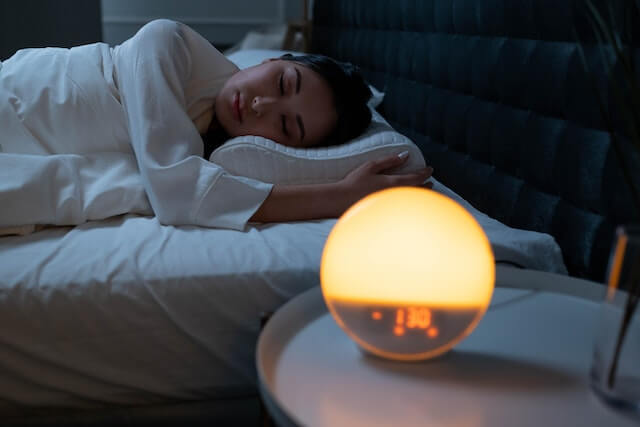
- Eat a healthy diet. Food additives and artificial colors in processed foods can worsen ADHD symptoms. So stick to a wholesome diet filled with fruits, veggies, whole grains, and lean protein. And if you have migraine, keep your trigger foods off the menu.
- Manage stress. As mentioned, stress is the #1 migraine trigger. And living with ADHD or migraine presents mountains of stress. So keep a lid on stress by setting aside time for daily relaxation – whether that’s yoga, meditation, or playing with a pet.
- Exercise regularly. Physical movement is a great way to boost your mood and burn off stress. But it also helps your brain! Research shows exercise improves memory and executive functioning and even promotes dopamine release. Just don’t overdo it, as intense exercise can trigger migraine for some.
Get nutritional support
Migraine and ADHD are both linked with certain nutritional deficiencies. Children with ADHD often have lower levels of vitamin D, magnesium, zinc, and iron. Luckily, research shows supplementing with these nutrients can improve emotional and behavioral problems that come with ADHD.
Migraineurs are often low in vitamin B2 (riboflavin) and magnesium. Evidence reveals supplementing with these nutrients may serve as a preventative treatment for migraine.
Fortunately, we offer nutritional formulas tailor-made for migraine and ADHD sufferers:
- Migrelief includes magnesium, riboflavin, and Puracol feverfew, for a triple shot of targeted nutritional migraine support.
- Attentivite comes in customized AM/PM formulas to improve focus, and support deep, restorative sleep.
Visit our shop here to check out all our migraine nutritional formulas and other condition-specific supplements.
Sources
- https://www.ncbi.nlm.nih.gov/pmc/articles/PMC3225610/pdf/406_2011_Article_203.pdf
- https://bmcneurol.biomedcentral.com/articles/10.1186/s12883-018-1149-6
- https://pubmed.ncbi.nlm.nih.gov/28587507/
- https://jamanetwork.com/journals/jama/fullarticle/184547
- https://journals.sagepub.com/doi/10.1177/0333102420929023
- https://news.umich.edu/brain-scans-show-dopamine-levels-fall-during-migraine-attacks/
- https://www.tandfonline.com/doi/abs/10.3109/15622970109026801
- https://my.clevelandclinic.org/health/treatments/11766-adhd-medication
- https://www.ncbi.nlm.nih.gov/pmc/articles/PMC7040528/
- https://migrainetrust.org/live-with-migraine/healthcare/treatments/supplements/
9 Health Conditions Associated with Migraines
There’s no question about it: migraines can be extremely painful and debilitating. Unfortunately, they can be even more challenging when a migraine sufferer has other health conditions which can also exacerbate their tendency to migraine and headaches. Migraines are associated with many other disorders including neurological and psychiatric disorders. When migraine occurs together with other illnesses at a greater coincidental rate than is seen in the general population, the occurrences are called “comorbidities”. A comorbid illness can create challenges when developing treatment strategies, especially for chronic migraine sufferers. Some treatments may be relatively contraindicated (not advised as a course of treatment due to potential harm) in individuals who have more than one disease.
Coexisting Conditions vs. Comorbidity
When two conditions are found in the same person but the incidence is not greater than what is seen in the general population, these are referred to as coexisting conditions. For example, a patient may have migraine and asthma. There is no evidence suggesting that these two conditions exist in a single patient more frequently than these conditions exist in individual patients in the general population. In contrast, migraine and depression appear to be comorbid because they occur together more often than they occur in individual patients in the general population.
- Insomnia
- Depression
- Anxiety
- Stroke
- Irritable bowel syndrome
- Epilepsy
- Hypertension
- Fibromyalgia
- Restless Leg Syndrome (RLS)
These illnesses are now recognized as being common migraine comorbidities.
Insomnia
Migraines and insomnia have a two-way relationship; poor sleep can trigger migraines, and migraines definitely can keep you from getting a good night’s sleep. It is estimated that one in four people have insomnia. Insomnia is a sleep disorder characterized by difficulty falling asleep, waking out repeatedly throughout the night, and not having a restful sleep. People with insomnia tend to get less than six hours of sleep.
Scientists believe that one of the reasons why sleep deprivation is so closely related to migraines has to do with pain processing. A research study published recently in the Journal of Neuroscience looked at the relationship between sleep and pain.
Researchers measured the brain activity and pain thresholds of 25 participants during one night of sound sleep and one sleep-deprived night. Their results showed that participants’ pain threshold was significantly lower when they were sleep-deprived than when they had restful sleep. Migraine sufferers should pay close attention to their sleep habits and if that isn’t enough, consider nutritional supplements for extra support. Melatonin, Vitamin B6, Magnesium, Glycine, Valerian Root, Zizyphus Jujube, and Hops are all well-known supplements for establishing healthy sleep patterns.

Stroke
A stroke happens when there is a sudden interruption in the blood flow to the brain, depriving it of the oxygen and nutrients that it needs to survive. When strokes are not caught in time, it can cause severe tissue damage and disability. Strokes are the fifth cause of death and the leading cause of disability in the United States.
There is not enough evidence to suggest that migraines cause strokes. However, several research studies have found connections between strokes and aura – the sensory symptoms that sometimes precede migraines. According to an investigation conducted by the American Stroke Association, individuals who have migraines with aura are 2.4 more likely to have a stroke than those without aura.
Epilepsy
Epilepsy, also called seizure disorder, is a neurological condition that causes seizures that originate in the brain. A person is typically diagnosed with epilepsy after they’ve had more than two unprovoked seizures.
Just like migraines, abnormal activities in the brain cause seizures. However, not everybody who suffers from migraines will necessarily develop seizures and vice versa. EEG scans have shown that the brain activity that during a migraine is similar to the activity that occurs during a seizure, but researchers are still trying to make sense of out that connection.
Heart Disease
Heart disease, also known as cardiovascular disease, is an umbrella term for a cluster of conditions that affect the health of the heart. Some of the conditions that fall under the heart disease group include:
- Atherosclerosis
- Arrhythmia
- Myocardial infarction
- Angina
- Congenital heart defects
- Heart infections
Heart disease and migraines do not have a comorbid relationship however, research suggests that migraines with aura increase the risk of developing heart disease, particularly within the first year of diagnosis. People with migraines also tend to have heart disease-related risk factors such as diabetes, high blood pressure, and an irregular heartbeat.
Anxiety & Depression
Anxiety and depression are the two most common mental health issues and are comorbid with migraine. In the United States, it is estimated that more than 18% of the population suffers from at least one type of anxiety, 6% from depression, and even more in the case of migraine sufferers.
According to the Anxiety and Depression Association of America, as many as 40% of people with migraines suffer from depression. Other mental health problems that are more prevalent among migraine sufferers are generalized anxiety disorder, panic disorder, bipolar disorder, agoraphobia, and substance abuse.

Irritable Bowel Syndrome
Irritable bowel syndrome (IBS) is a gastrointestinal disorder that affects the large intestine (aka the colon). IBS causes abdominal cramping, constipation and/or diarrhea, gas, and bloating. Though the cause of IBS is not known, doctors believe that faulty communications between the gastrointestinal tract (GI) and the brain may play an important role.
It is a well-known fact that nausea, vomiting, and digestive issues are common symptoms of migraine attacks. In fact, there is a type of migraine without headaches, called abdominal migraine, which occurs mostly in children but is now being diagnosed more frequently in adults. Now, recent studies have also discovered that people (especially women) who have IBS are more likely to suffer from migraines.
Fibromyalgia
Research studies show that there is a bidirectional relationship between migraines and fibromyalgia (FM). That means that in some cases, FM has been observed to trigger migraines and in others, migraines seem to provoke FM. It is estimated that between 45 and 80 percent of patients with FM suffer from chronic migraines and 18 to 35% of chronic migraine sufferers also suffer with fibromyalgia. According to a recent study in published in the British Medical Journal, fibromyalgia had stronger predictive power for the onset of migraine than did migraine for the onset of fibromyalgia.
Restless Leg Syndrome (RLS)
Restless legs syndrome (Willis-Ekbom Disease), causes uncomfortable sensations in the legs and an irresistible urge to move them. Symptoms commonly occur in the late afternoon and are often most severe at night when a person is resting. Symptoms are often worse at night making it difficult to fall asleep or return to sleep after waking up. Moving the legs or walking typically relieves the discomfort but the sensations often recur once the movement stops. Many clinical studies and recent meta-analyses of these studies have revealed a higher prevalence of RLS in patients with migraine compared to individuals without migraine. Several studies reported that RLS is 17.3–34 % higher in patients with migraine. Migraine patients who also had RLS were more likely to have photophobia, phonophobia, exacerbation due to physical activities, vertigo, dizziness, tinnitus, and neck pain.
The Comorbidity and Coexisting Condition Challenge
If you’ve been diagnosed with a physical and/or mental health condition, keep good records of the care that you receive from various professionals, so that each can be aware of the various treatments you are receiving and various therapies you are using. It is important to avoid negative drug interactions. Also, the treatments that benefit one condition may be detrimental for another.
If possible, prevent comorbid conditions from taking hold by addressing early symptoms as soon as possible. For example, if social anxiety disorder is left untreated for a long time, it may lead to depression and substance abuse. Don’t forget that good nutrition, filling nutritional gaps with dietary supplements and proper sleep goes a long way toward maintaining good health and longevity.
Better Sleep Patterns Can Decrease Migraines
For too many migraine sufferers, a good night’s sleep every night is an impossible dream.
A study done at the University of North Carolina by sleep specialist, Dr. Anne Calhoun found that by improving sleeping habits, women decreased their headache frequency by 29% and the intensity of the migraines they did get, by 40%.
When the number of migraine days per month is under 15, the patient is diagnosed with episodic migraine. If 15 or more per month, the patient is considered to have chronic migraines.
The women in this study originally had episodic migraines that over a course of years converted to chronic migraines. (This is called transformed migraine- i.e., transformed from episodic to chronic).
It is believed that transformed migraines can come about due to multiple factors like poor sleep habits and/or pain killing medication over-use.
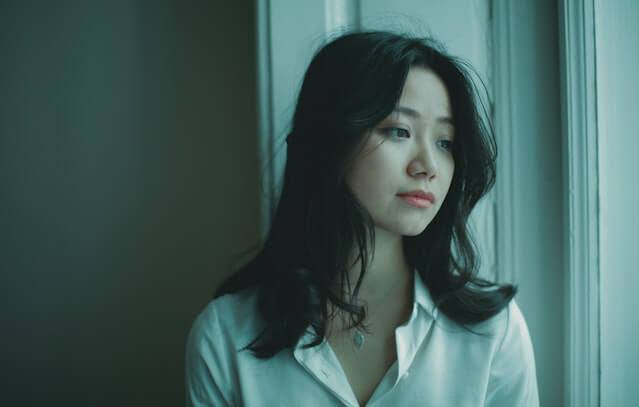
86% of the women in the study reported non-restorative sleep. In simple terms this means they still felt tired when they awoke in the morning. 80% of them watched TV or read in bed. 70% awakened between 1-6 times a night to urinate.
The women were instructed to:
- Move dinnertime to 4 hours before bedtime.
- Limit fluids taken 2 hours before bedtime.
- Allow for 8 hours of sleep and not to vary their bedtimes more than 30 minutes.
- Not to listen to music, read, or watch TV in bed.
- Not to over-use migraine medications.
- Stop taking naps (even though they were tired from poor sleep)
Improvements in migraine frequency happened rather quickly after implementing the “better” sleeping habits. Within a month and a half, 35% of the group reported fewer migraines.
By the end of 3 months 58% of the women who implemented the recommended sleep changes went back to being only episodic sufferers.
The good news is that these recommendations work and that all except one of the women who implemented ALL of the recommendations reverted to being episodic from chronic.
The bad news is that women who kept three or more of the bad sleep habits did not improve.
Discipline is important. Implement all of the recommended sleep changes, they are really not that hard.
What may also prove to be very exciting is to implement these sleep habit changes and combine them with doing 3-4 days a week of moderate exercise (i.e. brisk walking, moderate weight-resistance with dumb bells). Recent studies have shown that moderate exercise 3-4 days a week can prevent migraines as well as a prescription medication.
Need extra help falling asleep?
For those of you who need more intensive support with sleep challenges, I formulated a comprehensive sleep supplement called Sleep All Night for falling asleep faster, staying asleep longer and reaching the deep sleep stage where much of the body and mind healing and reset occurs.
Establishing healthy sleep patterns is the most powerful tool you have to maintain good health and extend your life. Learn more. And if you are a migraine sufferer, don’t forget to take your MigreLief!
I hope you find these suggestions useful and life changing.
To the best of health,
Curt Hendrix, MS, CCN, CNS
